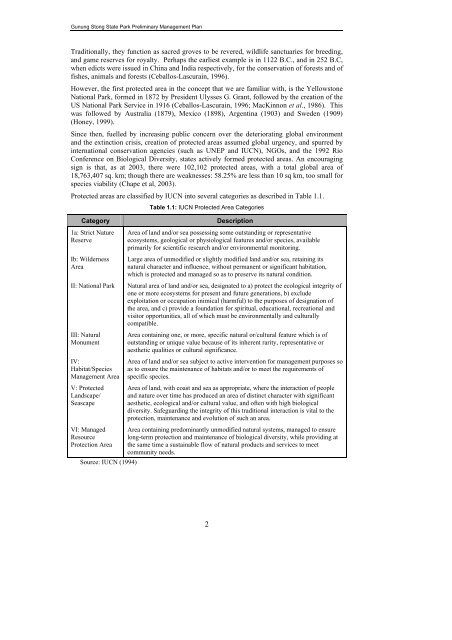FINAL VERSION FOR APPROVAL - Sdn Bhd - WWF Malaysia
FINAL VERSION FOR APPROVAL - Sdn Bhd - WWF Malaysia
FINAL VERSION FOR APPROVAL - Sdn Bhd - WWF Malaysia
Create successful ePaper yourself
Turn your PDF publications into a flip-book with our unique Google optimized e-Paper software.
Gunung Stong State Park Preliminary Management Plan<br />
Traditionally, they function as sacred groves to be revered, wildlife sanctuaries for breeding,<br />
and game reserves for royalty. Perhaps the earliest example is in 1122 B.C., and in 252 B.C,<br />
when edicts were issued in China and India respectively, for the conservation of forests and of<br />
fishes, animals and forests (Ceballos-Lascurain, 1996).<br />
However, the first protected area in the concept that we are familiar with, is the Yellowstone<br />
National Park, formed in 1872 by President Ulysses G. Grant, followed by the creation of the<br />
US National Park Service in 1916 (Ceballos-Lascurain, 1996; MacKinnon et al., 1986). This<br />
was followed by Australia (1879), Mexico (1898), Argentina (1903) and Sweden (1909)<br />
(Honey, 1999).<br />
Since then, fuelled by increasing public concern over the deteriorating global environment<br />
and the extinction crisis, creation of protected areas assumed global urgency, and spurred by<br />
international conservation agencies (such as UNEP and IUCN), NGOs, and the 1992 Rio<br />
Conference on Biological Diversity, states actively formed protected areas. An encouraging<br />
sign is that, as at 2003, there were 102,102 protected areas, with a total global area of<br />
18,763,407 sq. km; though there are weaknesses: 58.25% are less than 10 sq km, too small for<br />
species viability (Chape et al, 2003).<br />
Protected areas are classified by IUCN into several categories as described in Table 1.1.<br />
Table 1.1: IUCN Protected Area Categories<br />
Category<br />
1a: Strict Nature<br />
Reserve<br />
Ib: Wilderness<br />
Area<br />
II: National Park<br />
III: Natural<br />
Monument<br />
IV:<br />
Habitat/Species<br />
Management Area<br />
V: Protected<br />
Landscape/<br />
Seascape<br />
VI: Managed<br />
Resource<br />
Protection Area<br />
Source: IUCN (1994)<br />
Description<br />
Area of land and/or sea possessing some outstanding or representative<br />
ecosystems, geological or physiological features and/or species, available<br />
primarily for scientific research and/or environmental monitoring.<br />
Large area of unmodified or slightly modified land and/or sea, retaining its<br />
natural character and influence, without permanent or significant habitation,<br />
which is protected and managed so as to preserve its natural condition.<br />
Natural area of land and/or sea, designated to a) protect the ecological integrity of<br />
one or more ecosystems for present and future generations, b) exclude<br />
exploitation or occupation inimical (harmful) to the purposes of designation of<br />
the area, and c) provide a foundation for spiritual, educational, recreational and<br />
visitor opportunities, all of which must be environmentally and culturally<br />
compatible.<br />
Area containing one, or more, specific natural or/cultural feature which is of<br />
outstanding or unique value because of its inherent rarity, representative or<br />
aesthetic qualities or cultural significance.<br />
Area of land and/or sea subject to active intervention for management purposes so<br />
as to ensure the maintenance of habitats and/or to meet the requirements of<br />
specific species.<br />
Area of land, with coast and sea as appropriate, where the interaction of people<br />
and nature over time has produced an area of distinct character with significant<br />
aesthetic, ecological and/or cultural value, and often with high biological<br />
diversity. Safeguarding the integrity of this traditional interaction is vital to the<br />
protection, maintenance and evolution of such an area.<br />
Area containing predominantly unmodified natural systems, managed to ensure<br />
long-term protection and maintenance of biological diversity, while providing at<br />
the same time a sustainable flow of natural products and services to meet<br />
community needs.<br />
2
















